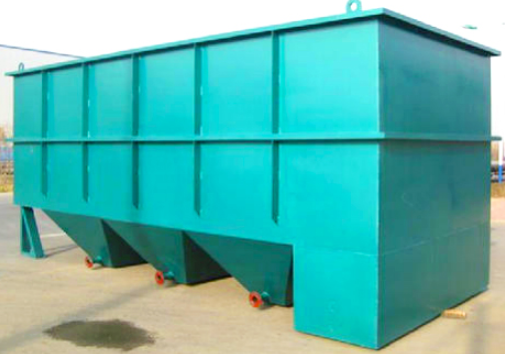Product overview
Sedimentation is a process that uses gravity sedimentation principle to remove suspended solids from wastewater, and the treatment facility is a sedimentation tank.
The sedimentation tank is mainly used to remove the solid suspended matter suspended in the wastewater that can be precipitated. The sedimentation tank before biological treatment is mainly used to remove inorganic particles and some organic matter. The sedimentation tank after biological treatment is mainly used to remove microorganisms.
The working principle of
Inclined tube sedimentation tank is a kind of high efficiency sedimentation tank, which is based on the theory of "shallow sedimentation". The inclined plate or honeycomb inclined tube assembly is placed in the sedimentation tank with a certain inclination Angle with the horizontal plane to improve the sedimentation efficiency. Many intensive inclined pipes or inclined plates are set in the settlement area to precipitate the suspended impurities in the water. The water flows upward along the inclined plates or inclined pipes, and the separated sludge slides down to the bottom of the pool under the action of gravity and is then discharged in a concentrated manner. This kind of pool can increase the sedimentation efficiency by 50%-60% and increase the treatment capacity by 3-5 times on the same area. According to the relative movement direction of the water flow and the sludge, the inclined plate sedimentation tank can be divided into three kinds: heterodirectional flow, codirectional flow and lateral flow. Because the sedimentation area is equipped with inclined plate or inclined pipe assembly, the sludge discharge of inclined plate (pipe) sedimentation tank can only rely on hydrostatic pressure.
Waste water flows in at one end of the sedimentation tank, flows horizontally through the tank, and flows out at the other end of the tank. At the bottom of the inlet of the pool, a mud hopper is set, and other parts of the bottom of the pool are sloping and inclined to the mud hopper. The plane of the inclined pipe sedimentation tank is rectangular, which is generally composed of inlet device, outlet device, sedimentation area, buffer zone, sludge area and sludge discharge device, etc. There are two kinds of mud discharging methods: mechanical mud discharging and multi-bucket mud discharging. Its advantages are: the use of laminar flow principle, improve the sedimentation tank processing capacity; The sedimentation distance of particles is shortened and the sedimentation time is shortened. The sedimentation area of the sedimentation tank is increased, thus improving the treatment efficiency. Disadvantages are: easy to plug, not as a secondary sedimentation tank, high cost. It is often used in the expansion and reconstruction of wastewater treatment plants, or in the application of wastewater treatment plants where land use is particularly limited.
Technical parameters
(1) The length-width ratio should be 4-5;
(2) The ratio of length to effective water depth is generally 8-12;
(3) The longitudinal slope at the bottom of the pool is generally 0.01-0.02, and not less than 0.005 when mechanical mud scraping;
(4) The maximum horizontal flow rate of the primary sedimentation tank is 7mm/s, and the secondary sedimentation tank is 5mm/s;
(5) Position of baffle at the entrance and exit:
A. Higher than the water surface of the pool by 0.1-0.15m;
B. Submergence depth of inlet baffle is generally 0.5-1.0m;
C. The submerged depth of exit baffle is generally 0.3-0.4m;
D. The baffle is 0.5-1.0m away from the water inlet and 0.25-0.5m away from the water outlet.
(6) When non-mechanical mud scraping, the buffer layer height is 0.5m. When mechanical mud scraping, the upper edge of the buffer layer should be 0.3m higher than the mud scraping board.
(7) The moving speed of the mud scraper is generally 0.6-0.9m/min;
(8) The diameter of the mud discharge pipe is > 200mm;
(9) The total opening area of the inlet rectifying wall is 6%-20% of the water crossing section;
(10) The outlet serrated triangular weir should be located at 1/2 of the tooth height.
Range of application
Inclined-tube precipitator can not only be used as the supporting equipment of water process such as air flotation method and uplift method, but also can single-stage treatment of a variety of sewage, for example.
1, electroplating wastewater containing a variety of metal ions in the mixed wastewater, copper, iron, zinc, nickel and other removal rates are more than 90%, general electroplating wastewater after treatment can meet the discharge standards.
2, coal mine, mineral processing wastewater can make turbidity in 500-1500 mg/rise to 5 mg/liter.
3, printing and dyeing, dyeing and bleaching wastewater color removal rate of 70-90%, COD removal of 50-70%.

Type selection reference table
model | Overall dimensions | processing | Equipment weight | Run the weight | |
1 | QRZCD-5型 | 3500×1500×2250 | 5t/h | 2.8 | 8 |
2 | QRZCD-10型 | 4600×1700×2500 | 10t/h | 3.3 | 13 |
3 | QRZCD-15型 | 6000×1700×2500 | 15t/h | 3.8 | 18 |
4 | QRZCD-20型 | 6500×2000×2500 | 20t/h | 4.2 | 25 |
5 | QRZCD-25型 | 6700×2000×4200 | 25t/h | 5 | 31 |
6 | QRZCD-16.66型 | 6900×2200×4500 | 16.66t/h | 6 | 37 |
7 | QRZCD-40型 | 8200×2200×4500 | 40t/h | 6.8 | 48 |
8 | QRZCD-50型 | 9800×2200×4800 | 50t/h | 8.1 | 60 |

There are 15 installation projects, 5 operation
projects and more than 40 other projects
16 installation projects, engineering and operation projects
8 items and nearly 60 items
There are 15 installation projects, 5 operation
projects and more than 40 other projects
16 installation projects, engineering and operation projects
8 items and nearly 60 items
There are 15 installation projects, 5 operation
projects and more than 40 other projects
16 installation projects, engineering and operation projects
8 items and nearly 60 items
There are 15 installation projects, 5 operation
projects and more than 40 other projects
16 installation projects, engineering and operation projects
8 items and nearly 60 items
